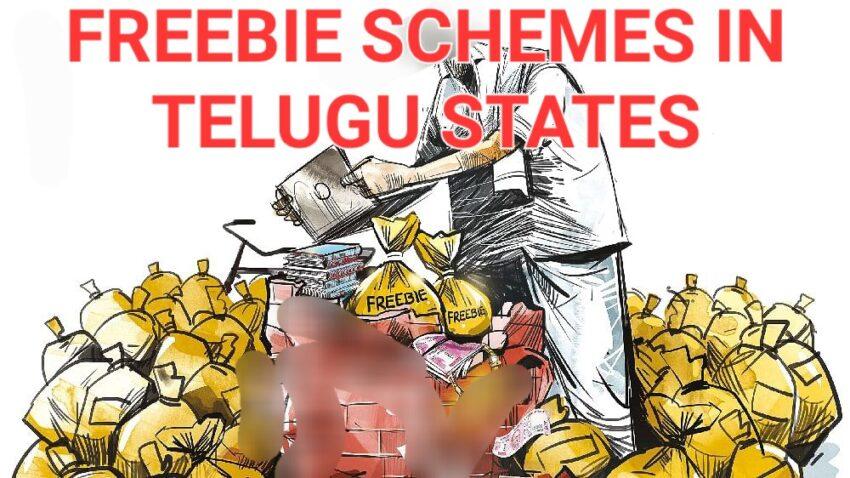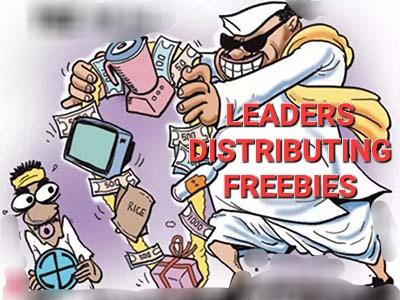Telugu states, which include Andhra Pradesh and Telangana, have been implementing various freebie schemes in recent years, including cash transfers, free food, and subsidies for various services. While these schemes have been popular with the public, there are concerns that they could be pushing the states into deep debt.
Both states have faced significant financial challenges in recent years, with Andhra Pradesh in particular struggling with a large debt burden. The implementation of freebie schemes has been a key part of the state’s efforts to improve the lives of its citizens, but there are concerns that the cost of these schemes is unsustainable.
Critics argue that these freebie schemes may be popular with voters, but they are not fiscally responsible. They point out that the states may have to borrow heavily to finance these schemes, which could lead to even more debt and potentially harm the long-term economic growth of the region.
However, supporters of these schemes argue that they are necessary to address the needs of the poor and marginalized sections of society. They argue that these schemes can help reduce poverty and inequality, and that the benefits of these schemes will ultimately outweigh the costs.
On the other hand states are borrowing recklessly as freebies empty their coffers. The burden of debt is more in States where more expenditure is being made on free schemes.
Significantly, both the deficit and the liabilities of the Central Government are very transparent and there is no possibility of misrepresentation of the same.

Prime Minister Modi has been repeatedly cautioning in his speeches that the politics of free ‘revadis’ (freebies) is ruining this country. It is seen that in the last one or two decades political parties in different states have been announcing different types of free schemes to woo the voters. Free electricity, free water, free women’s travel in public transport, cash transfer to all farmers based on their land, free Mangal Sutra, free Laptops, free scooters, free TVs and many such freebies schemes are frequently announced by the states. Many political parties have been the beneficiary of these freebies, and have been successful in capturing the governments in some states.
The Reserve Bank has said that the state governments are making public borrowing, over and above what was announced in the budget, which is a matter of concern. In the year 2020, the Andhra Pradesh government raised huge debt over and above announced in the budget. Apart from Andhra Pradesh, the Reserve Bank has cautioned 9 more states that their borrowings have far exceeded their capacity. Of these, Punjab, Bihar, Kerala and West Bengal are said to be under extreme stress. The Reserve Bank report states that the average government borrowing in Punjab, Andhra Pradesh, West Bengal, Haryana and Kerala is more than 5 per cent of their respective state GDP. Government borrowing is 9.6 per cent in Punjab and 6.1 and 6.0 per cent in Andhra Pradesh and West Bengal respectively. Apart from this, it is 5.3 per cent in Haryana and 5.1 per cent in Kerala.
It is worth mentioning that India is a Union of States, therefore the debt of both the central government and the state governments together is called General Government Debt. The FRBM Committee, given the FRBM Act 2003, had recommended in 2017 that the debt-to-GDP ratio of the General Government (both central and state governments) should be less than 60 per cent, with the debt limits of the central and state governments to be 40 per cent and 20 per cent respectively.
The year 2020-21 was extremely unfortunate for the country and the world. On the one hand, the income of the governments decreased by a huge amount and on the other hand, the expenditure on health, social services and food aid increased enormously, to deal with the pandemic. Naturally, the total liabilities of the Central Government as a proportion of GDP increased from 50.9 per cent in 2019-20 to 61.01 per cent in 2020-21. But after that, it decreased to 57.33 per cent in 2021-22 and to 55.88 per cent in 2022-23. Similarly, the total liabilities of state governments as per cent of GDP, which were 26.66 per cent in the year 2019-20, increased to 31.08 per cent in 2020-21, which later declined to 28.71 per cent in 2021-22 and 27.87 per cent in 2022-23. The total liabilities of the General Government (central and state governments together) increased from 77.56 per cent in 2019-20 to 92.09 per cent in 2020-21. After this, it decreased to reach 86.04 per cent in 2021-22 and 83.75 per cent in 2022-23.
Significantly, both the deficit and the liabilities of the Central Government are very transparent and there is no possibility of misrepresentation of the same. But the same cannot be said about the liabilities of the state governments. Recently, the Comptroller and Auditor General of India (CAG) has also made some observations about the budgetary and fiscal management of the states. In these comments too, concern has been expressed about the debt of the state governments based on the data till the year 2020-21. The CAG says the debt to GSDP ratio in most states is higher than the targeted 20 per cent (as per FRBM). It reached 48.98 per cent in Punjab, 42.37 per cent in Rajasthan, 37.39 per cent in West Bengal, 36.73 per cent in Bihar, 35.30 per cent in Andhra Pradesh, 31.53 percent in Madhya Pradesh, 27.80 percent in Telangana, 27.27 percent in Tamil Nadu and 26.47 percent in Chhattisgarh in 2020-21.

It is worth noting that the CAG’s figures for debt are different from the figures given by the state governments. And if borrowings of state government enterprises and guarantees given by the state government are also included, then by 2020-21, the debt GSDP ratio in Rajasthan would be 54.94 per cent and in Punjab, it would be 58.21 per cent. In Andhra Pradesh also it has been estimated at 53.77 percent. Notably, it has reached 47.89 per cent and 47.13 per cent in Telangana and Madhya Pradesh respectively.
It is 40.35 per cent and 40.51 per cent in West Bengal and Bihar respectively, and 39.94 per cent in Tamil Nadu. If the adjusted liabilities of these state governments as estimated by the CAG are compared with the figures provided by the state governments, it appears to be 10 to 20 percentage points higher. That is, it can be said that the burden of liabilities on the state governments is much more than the figures published by the state governments. Although, the liabilities of the Central and State Governments are more than the prescribed limit as per the FRBM Act, as per the assessment done by the CAG, the gap of the State Governments with the suggested limit in FRBM, is widening continuously.
Regarding Andhra Pradesh, the Reserve Bank of India says that Punjab is the highest spender on freebies. Notably, 45.5 per cent of the total tax revenue is spent on free schemes in Punjab and 30.3 per cent in Andhra Pradesh. Talking about the state’s gross domestic product, 2.7 per cent of the state’s gross domestic product is spent on free schemes in Punjab and 2.1 per cent in Andhra Pradesh. Apart from this, in Madhya Pradesh 28.8 per cent of the tax revenue is spent on subsidies, in Jharkhand this expenditure is 26.7 per cent of tax revenue.
Significantly, according to the assessment of the CAG, the general debt is more in those states, where more expenditure is being made on free schemes. In this, Punjab and Andhra Pradesh are at the top. Where the bulk of the total revenue is spent on free schemes. Apart from Andhra Pradesh, Tamil Nadu is another southern state which spends more on free schemes. Although Delhi is far ahead in free schemes, due to this debt Delhi does not increase because the per capita revenue of the state is almost twice that of the national arrangement.
However, due to free electricity, free water and free travel in public transport for women by the Delhi government, the financial condition of Delhi has become very precarious. All the promises made by the Aam Aadmi Party before coming to power, such as building 20 new colleges, providing free WiFi, building 20,000 public toilets, creating a women’s security force, installing 5 lakh CCTVs, expanding health facilities, creating 8 lakh jobs creation, skill training to one lakh youth etc. have all gone in the air till now. The civic amenities of Delhi are getting badly affected. Far from building new roads, flyovers, schools and colleges, Delhi’s health services are also getting badly affected.
When a state spends such a large proportion of its tax revenue on free schemes, its capital spending on essential services and infrastructure will naturally fall short. The debt on such a state government goes on increasing, due to which social services like education and health as well as transport and other essential services are also affected. For the development of any state, it is essential to increase investment. In the absence of infrastructure, investment is affected and due to this, the development of the state and creation of job opportunities is also affected. The development of the country must be accelerated by curbing the free schemes given by the states.
In conclusion, while the implementation of freebie schemes has certainly helped improve the lives of many people in Telugu states, there are legitimate concerns about the financial sustainability of these schemes. It is important for the state governments to balance the need for social welfare with fiscal responsibility, and to carefully evaluate the costs and benefits of these schemes before implementing them. #hydnews #khabarlive







